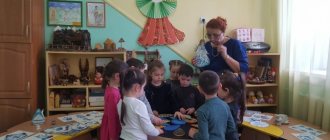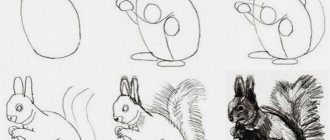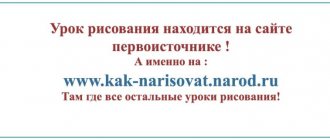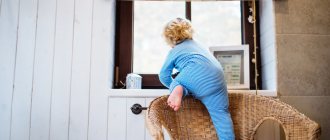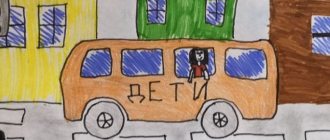Aspects that need to be taken into account when preparing for a drawing lesson in the middle group of a preschool educational institution
Suitable paints and base
When drawing dishes in the middle group, the teacher can offer children two options for the basis: these can be ordinary sheets of A4 paper (if children draw with paints, the paper is tinted in pastel colors in advance) or ready-made templates of objects (a plate, a cup with a saucer, a jar for canning vegetables, etc.). The second method is more relevant if the main objectives of the lesson are not just to convey the shape of the dishes, but to decorate them or supplement the image with vegetables and fruits. You can also offer preschoolers a template for dishes that are still difficult for them to draw on their own (for example, a teapot).
You can draw dishes with paints (gouache or watercolor) and colored pencils (as an option - wax crayons, felt-tip pens). A composition created with paints will be more vibrant, and pencils, in turn, can convey different shades of color.
Techniques and techniques used
The topic “Dishes” involves subject drawing, during which preschoolers learn to more or less accurately convey the shape of an object and its characteristic features. By drawing several pieces of utensils (for example, a cup and saucer), children learn to harmoniously place the image on a sheet of paper and repeat the silhouettes of identical objects (teapot and cups).
When painting with paints, children practice the ability to draw wide and narrow lines with a brush (all bristles and tips), paint over an image without going beyond its outline. Children learn to obtain new shades of paint by mixing them in different proportions - this allows them to convey the image more expressively. The technique of dipping is improved (when drawing various elements (flowers, leaves, berries) on dishes).
As for decorative painting, the teacher leads students in the middle group to the patterns in the structure of the pattern. Children learn to fill any shape with a pattern (a round plate, a cup that resembles half an oval, etc.). Moreover, the decorative decoration of the silhouette must first be preceded by the decoration of the finished form (the best option is a plate, since it has the shape of a circle). The ornament can be fantasy (the children come up with it themselves, based on the teacher’s samples) or created based on folk arts and crafts (haze, Gzhel, etc.).
Additional types of visual activities that can be used when drawing dishes
When drawing various pieces of utensils, it will be interesting for children to use additional types of visual activities, in particular, modeling and appliqué. So, a drawn jar of canned vegetables or fruits, covered with a glued lid made of colored paper, will look original. You can glue cut out paper fruits or vegetables onto a painted plate.
The saucer can be decorated with a border of small plasticine balls, and the cup can be complemented with a sculpted handle of a similar color.
The appropriateness of using an individual approach in a lesson on this topic
Many drawing classes allow you to customize the assignments based on design and level of difficulty. The topic “dishes” is no exception. So, if children color and decorate templates with patterns, then stronger children who cope well and quickly with the task can be offered to design another option, but only in a different way.
Another option is that for preschoolers who already have artistic abilities, you can make the tasks a little more complicated. For example, if the topic of the lesson is a plate of fruits or vegetables, then you can invite such children to depict objects that are a little more difficult to draw (grapes, corn, etc.).
How to motivate children?
We found out that children, due to their age, enjoy the process of drawing. But for a successful lesson, the teacher needs to choose a combination of techniques that would properly set up the little ones for work. Please note that this should not be one, but a set of techniques.
Conversation and visibility
In the list of motivational techniques, this pair will occupy a leading position, since at 3–4 years old, visual-figurative thinking is the leading one for children, that is, they must see or clearly imagine what is being discussed. So pictures, photos, real dishes - this is the set that should be before the eyes of little creators.
Visualization must be accompanied by a detailed explanation
Any demonstration is accompanied by a story from an adult and a conversation about what was heard - this is an axiom of the method of working with children. The following set of questions can be suggested on the topic:
- “What does it mean to be a hospitable host?”;
- “What is tea party?”;
- “What are the dishes for?” (as an option - individual items of kitchen utensils);
- “Do you (your family members) have a favorite cup?”;
- “Why did the dishes escape from Fedora?” etc.
Poems
Children love to listen and recite poems. For motivation, you can invite the kids to tell or listen to an excerpt from Chukovsky’s poetic fairy tale “Fedorino’s Grief,” as well as a whole series of funny rhymes.
Table. Examples of poems about dishes
Puzzles
Guessing riddles has one undeniable advantage compared to other motivational techniques - children immediately get involved in the work because of the excitement of guessing what is encrypted in it.
- Granny cooks soup for us in it. There is ... (saucepan) on the table.
- It is necessary for us, because we eat food from it. Deep and shallow they call it... (a plate).
- On the stove is the boss of the pots. Thick, long-nosed...(teapot).
- I puff, puff, I don’t want to get warm anymore. The lid rang loudly: Drink tea, the water has boiled! (kettle).
Children can, when solving riddles, not only name, but also show the encrypted object
Fairy tales
There are no less fans of listening to fairy tales in children's groups than there are fans of poems and riddles. In addition to the already mentioned fairy tales “Fedorino Woe”, “Pinocchio”, “Three Bears”, children can be asked to work through (listen to, answer questions, draw the main character) the following stories:
- Once upon a time there was a teapot. He had a family of dishes. The teapot was pot-bellied. It had a handle, a lid and a small spout with one nostril. The kettle was iron and very useful. People loved it and drank tea from it.
- I am a large enamel pan. I am blue. My insides are all white. And brilliant. I'm very proud of it. I help people prepare soups and main courses, and people love me for this.
Lesson notes - variations on the theme “Dishes”
| Author's full name | Title of the abstract |
| Osintseva P.P. | “Decorating a cup” Educational objectives: learn to decorate a template of an object, draw dots and thin lines with the tip of a brush, and wide ones with the entire pile, consolidate the ability to thoroughly rinse the brush before using another paint, Developmental objectives: consolidate the general concept of “dishes”, the ability to classify utensils (tea room), activate vocabulary, develop attention, imaginative thinking. Educational objectives: to cultivate independence and initiative. Integration of educational areas: “Artistic creativity”, “Cognition”, “Communication”, “Socialization”, “Health”. Demonstration material: Dunno doll, Whatman paper with a picture of a teapot in the middle. Handouts: cup templates according to the number of children, gouache, brushes, sippy cups. Progress of the lesson: A surprise moment - the appearance of Dunno, who comes with “broken” dishes - cut-out pictures. He tells the children that he was in such a hurry to get to them, and that’s why he fell and broke all the dishes. The teacher and the children calm Dunno and promise to help him. A didactic game “Collect a picture” is played: children are given envelopes with cut-out pictures and they collect the whole image - they “repair” the dishes. Next, Dunno asks the children riddles about dishes (the teacher shows the corresponding pictures). Particular attention is paid to the teapot:
Its structure (spout, lid, handle) and purpose are discussed in detail. Dunno reports that he has cups, but they are not as beautiful as a teapot, without a design. The children happily agree to decorate them. The teacher examines with the children the design on the teapot - a beautiful flower with blue petals and a yellow center with a red border. Please note that the ornament on the cups should be exactly the same - after all, this is a tea set. The teacher demonstrates the decoration of one of the templates and leaves the sample on the board. Before directly productive activities, finger gymnastics “Mom’s Helpers” is performed: Independent activity of children. At the end of the lesson, Dunno praises the guys and invites them to visit for tea. |
| Harutyunyan M.A. | “Plates” (drawing with pencils on paper circles with a diameter of 6–8 cm) The motivation for the lesson is interesting - the teacher creates a problematic situation: on the way to work, she met two dogs who said that they were going to visit their bunny friends. The phone rings - the little bunnies are calling and crying because their plates have broken. They were so beautiful, and now there is nowhere to put treats for guests. The teacher invites the children to help the bunnies, shows the preschoolers several plates with different patterns, and focuses attention on its location. At the end of the lesson, toy bunnies appear and ask the children to help them wash and tie bows. They say goodbye and thank the guys for the beautiful plates. |
| Ermakova I. | “Decorative dishes” (painting a cup with a Khokhloma pattern) At the beginning of the lesson, the teacher makes riddles about the dishes, informs that there are several varieties of them: kitchen and dining room, tea room and for storing food. A didactic game is offered - toy dishes need to be sorted by type. Cups with various patterns are considered. And here a motivating moment arises: the teacher informs the children that, it turns out, the kids in the nursery group just have white cups, and they would like to help - decorate the dishes with Khokhloma patterns. |
| Berdnikova E.N. | “Tea couple” This lesson is held on the eve of the March 8 holiday. The teacher offers to please their mothers with a gift - a drawn pair of tea. Reading a poem
Children paint over the silhouettes of cups and saucers and then decorate them with patterns. |
| Fedotova E. | “Plate” (decorative drawing based on Dymkovo painting) The lesson unexpectedly begins with a riddle about a hare. Then a sad toy bunny appears in front of the children. He tells the children that when he went to their kindergarten, he met the Dogs Trezorka and Bulka in the yard, so beautiful, with shiny fur and bows. It turns out that they were going to visit friends with their mother. The bunny also wants to receive guests, but he has no plates. The teacher invites the children to first draw plates on a sheet of paper and then decorate them with Dymkovo patterns. In front of the children are albums with samples of this painting, as well as toys and dishes. |
Samples with a step-by-step description of the order of work within the designated topic in the middle group
Photos 2 and 7 show children’s drawings “Tea Couple”. In the first version, paints were used as a material, in the second - pencils.
We see the painting of the saucers in photos 11 and 12 - a drawing based on Dymkovo arts and crafts and a fantasy ornament of apples and berries.
The theme of dishes opens up great opportunities for the use of non-traditional image techniques. In this regard, photo 3 “Tea set on a napkin” is interesting, where the teapots are decorated with fragmentary appliqué (napkins). Photo 6 (“Teapot”) shows us a drawing using fingers. The original works are in photos 8 and 9, where fruits are depicted using apple halves.
Subject compositions - vegetables and fruits on plates - are presented in photos 4, 5 and 10. Here, orientation on a sheet of paper and the ability to harmoniously arrange objects in a drawing are already more developed.
"Dishes"
Drawing: pencils.
Material:
Colour pencils
Progress of the lesson:
Problem situation
Story pictures
Plot pictures on the topic “dishes” are also very useful for speech development. They allow you to compose not only descriptions, but also entire stories.
The pictures “Mom Washing the Dishes” or “Happy Tea Party” help a 3-year-old child come up with a few simple sentences, and at 6 years old the same illustrations can be used to compose a detailed narrative.
Pictures with a plot must be selected for each group of dishes, i.e. the pictures should show a kitchen and a dining room. It’s good if children can see washing dishes, cooking, and decorating a festive table.
Narrative paintings provide an opportunity to practice writing stories, as well as train attention, imagination, and memory.
Preview:
Topic: "Dishes"
"Dishes"
Drawing: pencils.
To develop the ability to draw circles, focusing on a support in the form of a round sheet of paper
Encourage children to help those in need
Material:
Colour pencils
Paper circles 6-8 cm in diameter
Progress of the lesson:
Problem situation
Today, on the way to kindergarten, I met two dogs, they were happy that they would go to visit their familiar bunnies.
Do you guys like to visit?
At this time the phone rings, the teacher picks up the phone:
Hello! I'm listening to. Are these bunnies? Yes, we already know. that you will have guests. What are you saying? And everyone crashed? Oh, what a pity! The plates were beautiful. No problem, don’t worry, we will help you.
The teacher addresses the children.
Guys! The bunnies are in trouble. They wanted to set the table, but a tray of plates fell and all the plates were broken. Now they don’t know what to put the treats in for the guests.
The teacher invites the children to make plates. Having received consent, he distributes paper circles and suggests that in order for the plates to be beautiful,
Learn to decorate them with stripes. It is advisable to look at several plates decorated with different patterns with the children and draw the children’s attention to the location of the pattern. After the children have completed the work, the teacher, on behalf of the bunnies, asks to tell who has which plate.
Then the bunnies ask the children to help them dress up: wash their faces and hands, go to the hairdresser, get their hair done, tie bows. Saying goodbye. the bunnies kiss the children and thank them for the plates.
Oksana Sivko
Summary of a lesson on fine art activities (drawing) in the middle group of the ZPR on the topic “Dishes” “Let's decorate the saucer beautifully”
Lexical topic “Dishes”
Conducting a survey
1. We presented the results of education for children and adults in the form of a diagram
2. Among the most famous fairy tales were the following:
15 people out of 27 respondents chose the fairy tale “Aibolit”.
We have compiled a word cloud based on the fairy tales of K. I. Chukovsky
And this is what children and adults said about fairy tales:

